Wild Eats: How to forage for your supper
The British isles are teeming with edible plants, animals and fish, but knowing how to find, identify and cook them takes skills and a good eye. We sent Will Robson to the Lakes to see what he could forage for supper
“Is the panna cotta set?”
Not the first thing I expected to hear from wilderness guru Ben as our encampment slowly begins to wake up, deep in the woods a few miles west of Lake Windermere.
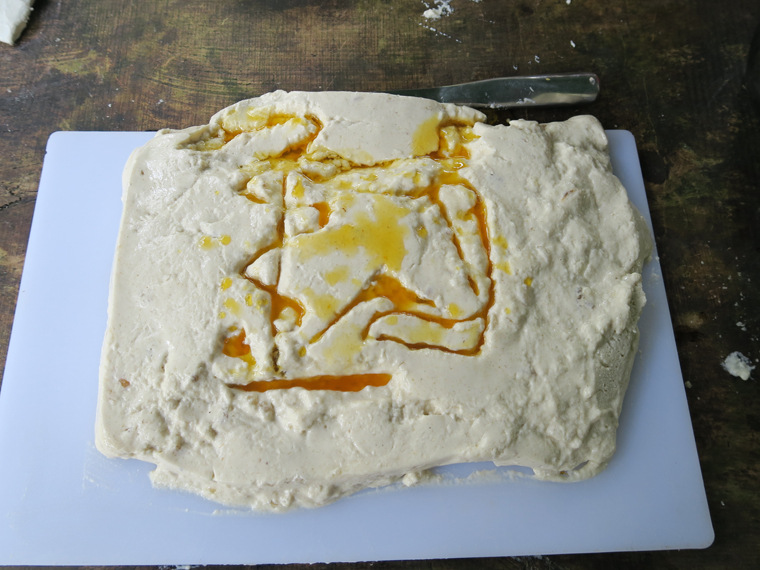
Seaweed panna cotta
But then Ben McNutt, who with partner Lisa Fenton set up Woodsmoke, a bushcraft and survival training company in 2001, has nothing to prove when it comes to living at one with nature. He and Lisa spent four years apprenticed to Ray Mears in the nineties and have since travelled, lived and gathered vast bushcraft knowledge all over the world.
I’m signed up to Woodsmoke’s spring foraging weekend course and despite springtime being a tad late this year, it’s been nothing but good eating so far. Case in point: we’re about to tuck into seaweed panna cotta.
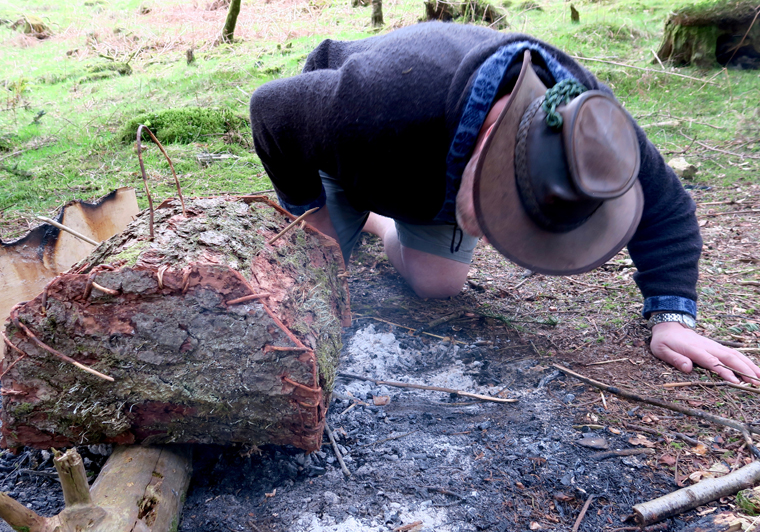
Brian watches his home made mackerel hot smoker
My fellow students are, for the most part, way ahead of me in bushcraft skills; many have become Woodsmoke course regulars. As I wander in under the parachute canopy, strung up as the camp’s hub, coffee press in hand, Pete is on his knees blowing last night’s dying embers back to life. How he isn’t drunk on hyperventilated oxygen, I don’t know; but his efforts are so strenuous and sustained that I feel obliged to actually help.
Therein lies the essence of bushcraft and why it isn’t everyone’s cup of coffee. It takes manual labour, dexterity, planning and a set of esoteric skills with cutting tools and non-swiping tinder to make
said coffee.
For this weekend at least, Man’s relentless march towards a life of ever-increasing convenience and comfort has been deliberately left a mile down the track we hiked up to reach Woodsmoke’s leafy lair. Or in my case, modernity was left on an empty plate at the Cuckoo Brow Inn in nearby Far Sawrey, as I wolfed down a burger and chips in case there was nothing to forage. The shame still burns hot.
A foraging we shall go
During our first foraging foray, Woodsmoke’s crew of green garbed instructors, knives dangling from belts, move through the stands of Larch and Beech with nonchalant ease, seeing things to eat that heretofore have passed me by. Ben grips a Larch branch: the tender bright green needles clumped along its length make good eating. To help identify it in future we archive the term “Larch lumps”, and others such as: “Yew uniform”, to which I add “Yew: untimely death” to my notes.
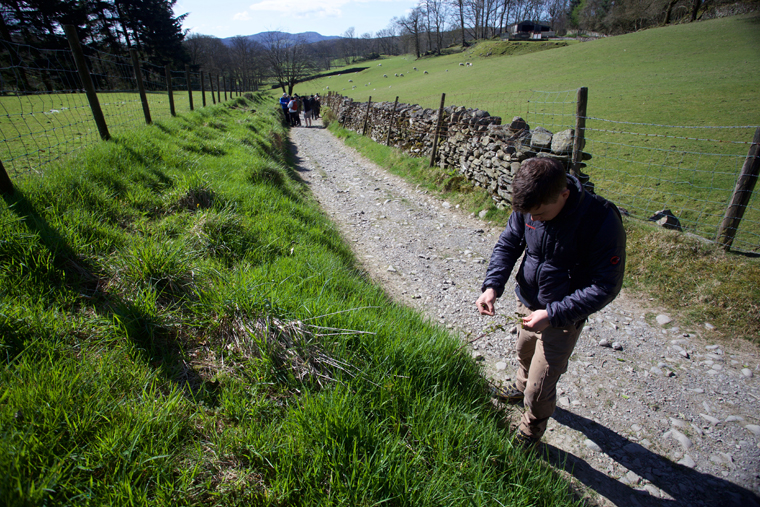
Seeking sorrel
And it’s true. The fields, woods, hedgerows, meadows etc, are amok with edible, but also toxic plants. The Eastern Hemlock conifer’s needles make excellent tea but the Hemlock plant will numb you from the toes upwards until your heart stops – as Socrates discovered.
Ben’s knowledge and delight in finding things for the pot or to nibble on the move is inspiring. It helps too that the weather is fine as some are taking copious notes. Ben tells us that the Comfrey root he’s whipped from the earth is edible but it does make him throw up. Its fibrous strands are very strong and can be used to make a plaster cast. Ben’s theory is that Comfrey’s ancient nickname of “knit-bone” is derived more from this external use of the root than the Allantoin chemical compound within it.
We fill our wicker baskets with dandelions (which I have no trouble spotting), beech leaves, sorrel and that all time favourite: nettle. No gloves are needed if you gently cup the tender nettle top from below and pull upwards, deftly avoiding the nettle’s histamine hypodermic stingers. Yeah, right.

Numb fingers aside, foraging is fun and fruitful, although there are no fruits at this time of year. Woodsmoke’s autumn foraging course harvests fruits and berries ripened over the summer, along with mushrooms. This is where the foraging bushcraft student must attune to the precious windows of time that the seasons leave ajar only briefly. Our delicate beech leaves and nettle tops will be unappetising in just a few weeks, so we must make hay while the
sun shines.
Self-suffishency
Back at camp, for all Ben’s assurances that nettles are packed with vitamins and minerals – they are actually delicious – I’m worrying about the lack of protein; we’ve snared no rabbits; we’ve felled no Muntjac. As with berries and mushrooms, game meat is the subject of Woodsmoke’s autumn course; for the spring course, we rely on the sea.
Ben’s partner Lisa Fenton (see interview on p16) arrives with boxes of fish and crustacea from the Cumbrian port of Whitehaven. This is more like it and as the team sets out what needs to be prepared for our feast, I can now see why those who’ve done the course before have been gently salivating since they saw the cool boxes unloaded.
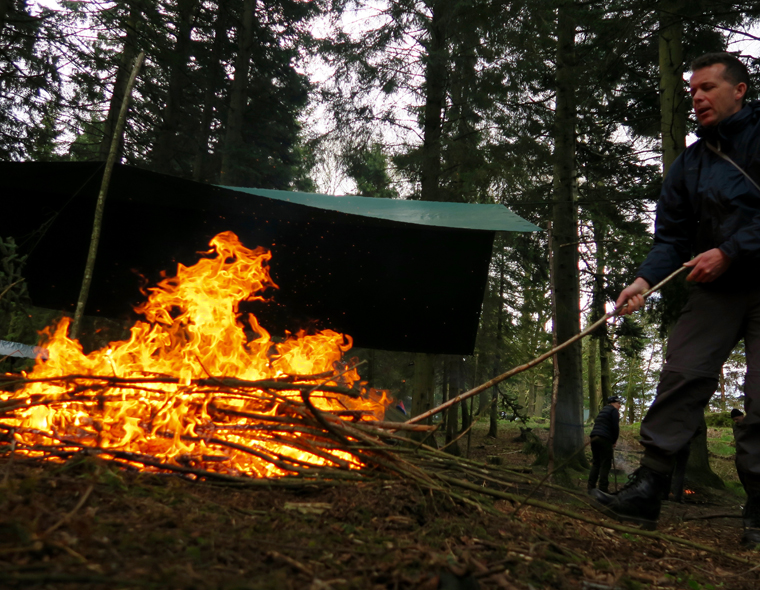
But to cook, we must first build fires. More wood collection: nothing from the ground as it will be damp: all must be taken from the larch, pine and other conifers around us. The lower branches are dead and dry, perfect to burn down in their shallow trenches until a glowing bed of ash and low flickering flame provides perfect cooking conditions.
Ben and Ross Bowyer – a survival consultant to Bear Grylls, no less – show us how to fillet sea bass and plaice; easily remove the alimentary tract from a crevette; and how to ponasse a salmon. This last technique involves splitting a hazel rod, removing all the fish’s bones, flaying it out on hazel cross-members, sliding it down the split rod and lashing it all up into what looks like a lacrosse stick. Fear not: I have a picture (see p58). The metre long stick is stuck into the ground, leaning the flesh side of the salmon over the fire. To ensure it cooks evenly, the four-count hand test is applied. The ideal distance from the fire is that point where you can hold your palm to the flame for four seconds and no more.
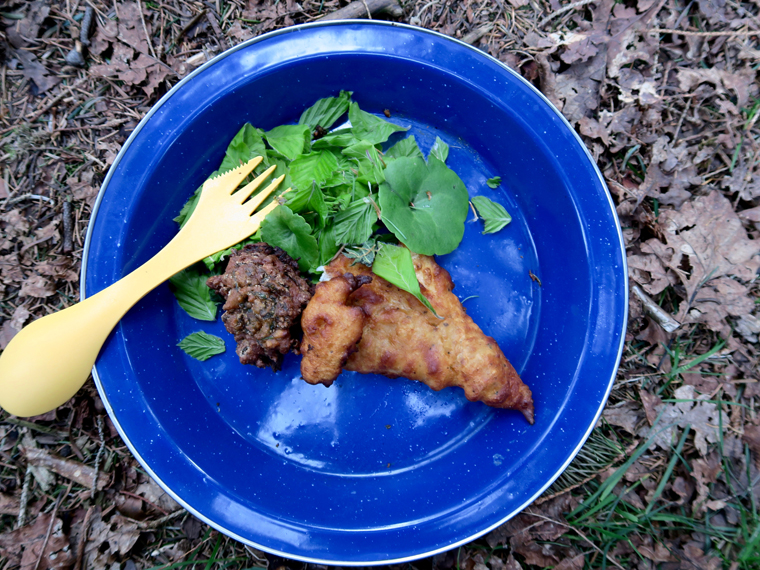
Tempura Sea bass, sorrell and nettles
All this preparation, and learning the skills needed to do it, are quite therapeutic. I’m hungry, but the anticipation of such wholesome eating makes the fish and lobster (did I mention there was lobster?) taste all the better. My fellow students have also settled into a glutinous reverie, picking at their plaice and cracking crab claws with bushcraft knives.
Ben has rustled up a spicy soup with fish balls, nettles and sorrel. He’s also dipped pieces of fish and dandelion flower in tempura batter and fried them in hot oil. There’s no denying that we are gorging on delicious food.
Ben is fast dispelling my misconception that survival experts may possibly delight in discomfort for the sake of it. The opposite is true. Ben is not only a great cook; he is also an artist, who has illustrated many of Ray Mears’ books.

Ross demos fine bannock bread baking
This renaissance man and his team are showing us that if you have the skills, interest and knowledge, living in the woods can be a highly rewarding past time; not some quasi-survival situation.
The students Woodsmoke teach come from all sorts of backgrounds, and for some, like me, it’s their first bushcraft course. But most here are dedicated to the hobby of bushcraft and have been for many years. Which is how I’ve come to develop knife envy.
Blades of glory
I’ve never felt the need to walk around with a sheath knife on my hip before, but I do now. I’m using a £7 Hultafors knife, loaned by Ben and good enough for my needs, but others are sporting what can best be described as works of art; handmade by craftsmen in tiny forges in Herefordshire, with a waiting list and a £300 price tag.
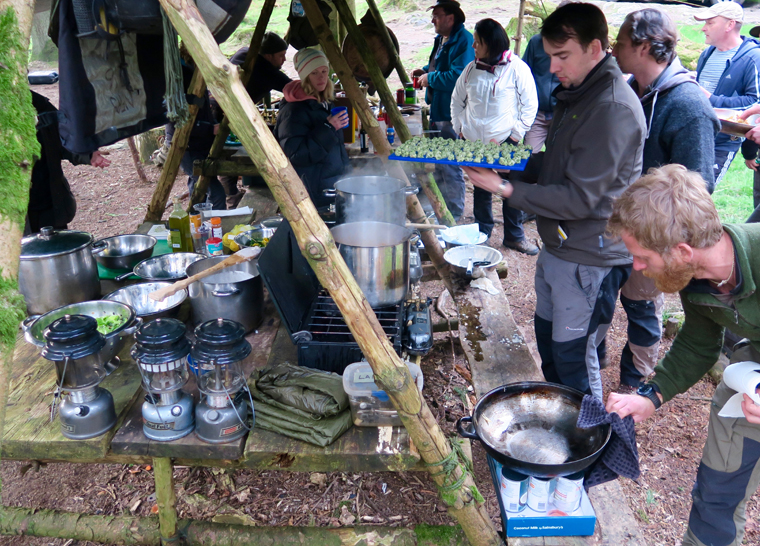
It may seem indulgent but it’s become clear that good cutting tools are vital to comfortable living in the wilderness. For example, a bushcraft blade must be strong enough to be hammered through a (modest-sized) log to split it for firewood, but it must also be delicate enough to filet a fish.
Woodsmoke runs courses just to show people how to use knives, axes and folding saws effectively, and time and again I witness instructors and others using knives and axes to fashion what they need from wood, or to make cordage from roots, for example. It’s impressive.
Seaweed and Bannock burn
Considering the course runs only over a weekend, there seems no end to the amount of eating and learning we’re doing: bushcraft is the hobby that keeps on giving. As I sit making notes in my small tent atop a hillock at the edge of camp, the aroma of baking bread wafts under the flysheet. Ross is demonstrating how yet another staple wilderness food can be cooked perfectly well in the open air. Bannock is the traditional woodsman’s name for a pan or pot baked loaf.
It doesn’t rise much as there’s no yeast, although Ben shows us an ancient sourdough yeast brew given to him by a Russian that dates back to before the revolution. I exaggerate possibly, but it’s definitelyvery old.
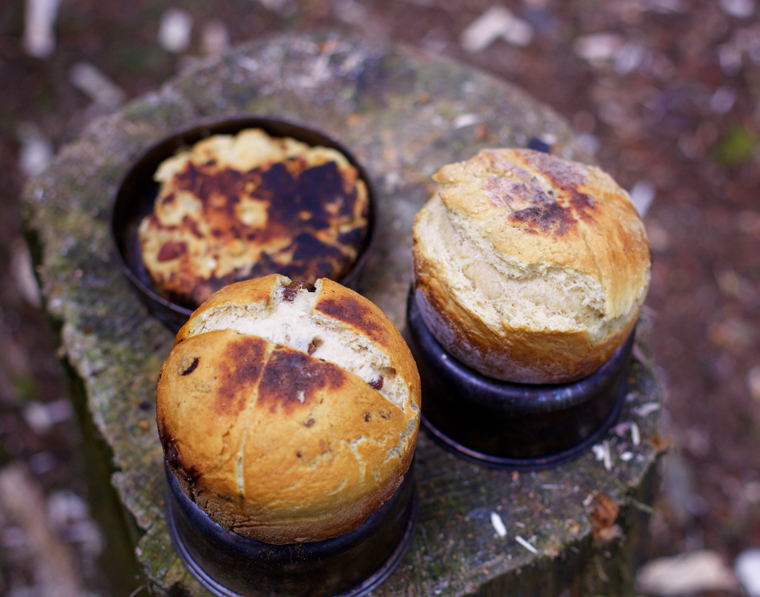
Three types of bread
We students help ourselves to various flavourings to the basic dough. Despite clear instructions, my dough is more Westmoreland ale with a little flour added, and currants. My pot rests on the embers and frequent checking, by poking it with a stick, results in a surprisingly tasty but highly perforated bannock, singed only slightly.
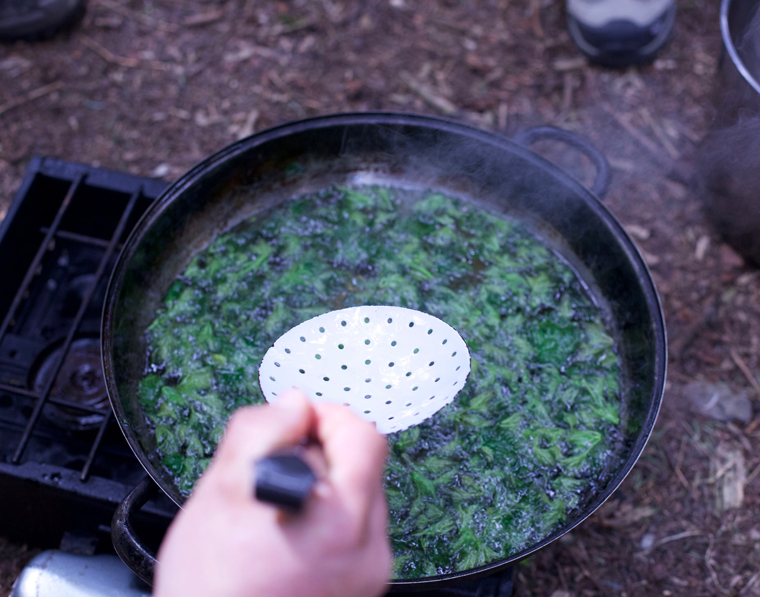
Nettles fried in oil
We are not yet done with the sea. Irishman Ben has ordered in seven varieties of seaweed from his native Donegal and is swiftly deep-frying them for us to test and discuss. The seaweed spaghetti tastes like bacon and only a couple of varieties remind me they were recently slimy salty plants. That said, the panna cotta we tucked into after the fish would not have set without the seaweed ingredient. They just don’t call it seaweed when used commercially.
Back to life, back to reality
All too soon the weekend is over and I’m driving south from the Lake District on a Sunday evening, enjoying that tingling, wind-swept, slightly sun burnt feeling of having been continually outside for a few days.

Nettle, sorrell and potato soup
The enthusiasm the Woodsmoke team and the students have for bushcraft is infectious and it’s easy to see why so many go back time and again, to build their knowledge and re-connect with a more elemental, self-reliant lifestyle. As we left camp, Ben reminded us that there are still spaces on his Borneo trip next year. There’s an idea.
Learn more
The best way to build foraging confidence is to learn directly from the experts. Book yourself on a Woodsmoke course. Their autumn harvester course costs £295 per person, all-in, and runs 16-18 September.
